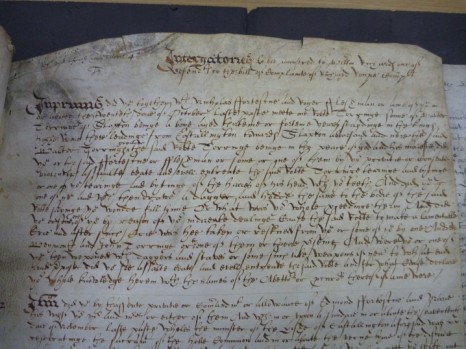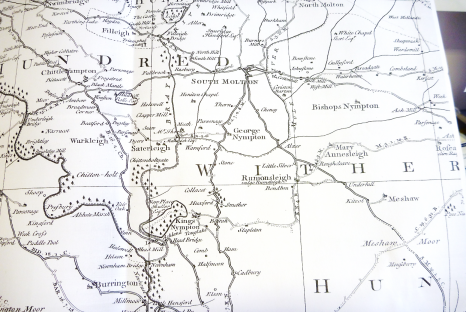sotonDH Small Grants: Introducing ‘Mapping Libel Performance in Early Modern Devon’
Accounts of early modern libel survive in the Star Chamber records, from which I have transcribed the Devon cases; these libels, I argue, should be seen as public performances and analysed in light of this. Having received a SotonDH grant, work has begun on a digital mapping resource which aims to present instances of performance-based libel from the county of Devon alongside key features of the contemporary landscape in order to demonstrate their performance nature.
This first blog post will introduce my research and outline the project’s aims and initial stages.
The Offence and Performance of Libel in Early Modern England
Libel – the creation and spreading of a message in order to defame somebody – was an offence on the rise throughout England at the end of the sixteenth and beginning of the seventeenth centuries. The increase in the number of libel offences at this period is said to be due to a series of high profile cases which set a precedent and a change in the definition of libel in the late sixteenth century from a moral offence tried in the church courts to a criminal one tried in the national court of Star Chamber (W. S. Holdsworth, A History of English Law, 7 Vols., Vol. V, (London: Methuen & Co. Ltd., 1903-24, 1924). Once tried in Star Chamber, libellers were punished for the ability of their libels to cause breaches of the common peace. Commonly, provincial libels of the early modern period contained a public confrontation or humiliation carried out in a communal space within the town or village followed by some attempt to disseminate abroad, either by written text or symbolic object, or by singing or reading aloud, the contents of a libel. Examples of libel content from Devon include verses, letters, playing cards with writing on them, cuckold’s horns with various embellishments and mock-royal proclamations. Our knowledge of these communal events comes from the court records of their subsequent trials in the Star Chamber. These records normally include a bill of complaint, submitted to the court by the victim, outlining what was done by whom. They also include lists of interrogation questions to be ministered to witnesses and defendants (see figure 1) and accounts of the examinations that followed.

When it comes to interpreting these instances of community conflict, libel and slander cases have received considerable attention from historians who have viewed them as giving insight into the everyday lives of people in a way that is difficult to find in other sources of national scope. They have been used by those historians to shed light on the levels of literacy at the lowest parts of society and to reveal the exposure to printed sources and political opinion that these communities experienced (Adam Fox, Oral and Literate Culture in England 1500-1700 (New York: Oxford University Press Inc., 2000). Whilst some literary scholars have highlighted how important it is to place libels in a literary context, they have tended to focus only on examples of libel from the royal court and those which commented on issues of national political scope (McRae, Andrew, ‘The Literary Culture of Early Stuart Libeling’, in Modern Philology, Vol. 97, No. 3 (February 2000), pp. 364-392); these high status political libels are different to the popular provincial cases examined in my work. Whilst early studies by Martin Ingram and C. J. Sisson came close to a literary analysis of early modern provincial libels, there has not yet been any large scale analysis of these cases as instances of communal performance. My work argues that these libels should be seen as examples of performance in the provincial communities of early modern England.
Digitally Mapping Libel in Devon
My work on libels began by focusing on cases from the south west of England and used the Records of Early English Drama (REED) volumes for the counties of Dorset, Cornwall and Somerset in order to do this. However, due to different editorial procedures used in REED’s early stages, the cases for libel in the county of Devon were not taken into account when the Devon REED volume was published. Therefore a large part of my thesis focuses on the records for libel in Devon held at the National Archives; by examining all of the cases for one county, instead of only those cases which were used in the REED volumes, I have been able to gain an overview of the offence and its relationship to performance. This study of the 23 cases of libel that occurred in Devon between 1603 and 1625 revealed a spectrum of performance ranging from the minority that were unperformed, through those that used public display, to those that used oral texts and visual symbols to perform messages in public places to an audience of the local community. My work so far has begun to interpret the libels in relation to the deliberately public and socially significant spaces of roads, boundaries and buildings in which they were performed, and one of the most visually striking ways in which this can be demonstrated is by mapping their locations onto the contemporary landscape.
Project Aims
The ‘Mapping Libel Performance in Early Modern Devon’ project takes a small sample, 10 cases in 8 locations, from the Devon material and aims to create a pilot resource presenting a map of early modern Devon with key landscape features highlighted and libel locations marked using GIS mapping software. The resource will include an overview of the county so that the 8 libel locations can be viewed in relation to the county road network system and other features such as hundred boundaries. The resource will also map the locations involved in each libel case in more detail so that the specific use of local geography by individual cases can be seen (see figure 2). Each libel case will also have information about the conflict and those involved attached to its significant locations in order to communicate a narrative for each case.
This resource will not only demonstrate my central argument in a visual medium, it will also make my research data easier to analyse and compare. Having information for each case linked to each significant location will allow comparisons between cases in terms of the status of those involved, the libel form and content, the causes and distances travelled, for example. Thinking beyond the offence of libel, these instances of the communal performance of conflict, when presented as a visual and searchable database, could then be compared to more traditional dramatic performances in order to determine their relationship to contemporary literature and culture.

As a pilot resource, the mapping project will also show the potential that digital technologies hold for presenting these types of sources in ways which make them more widely accessible, not only to scholars, but also to members of the wider public with an interest in the local history of their own communities.
Initial Stages: Collaboration
This project will be achieved through collaboration across disciplines and so presents an exciting opportunity for interdisciplinary work. Initially, this has involved gathering my research data and communicating my arguments to Archaeological Computing Research Group member Philip Riris who will then use mapping software to produce the pilot resource. As work continues, I will be learning the basics in using this software and I have already begun to appreciate its capabilities for presenting my research.
The second blog post for this project, focusing on the methods used for mapping libel performance in early modern Devon, will follow soon.
Bibliography
Primary Sources
Alexander, Robert J., & James Stokes, eds, The Records of Early English Drama: Somerset, 2 vols (Toronto: University of Toronto Press, 1996)
Donn, Benjamin, A Map of the County of Devon 1765, ed. by W. L. D. Ravenhill (London: Percy Lund, Humphries & Co. Ltd., 1965)
Hays, R. C., & C. E. McGee, S. L. Joyce & E. S. Newlyn, eds, The Records of Early English Drama: Dorset & Cornwall (Toronto: University of Toronto Press, 1999)
London, The National Archives: Public Record Office, STAC 8 & 12/1
Select Secondary Sources
Barnes, Thomas G., ‘Star Chamber Mythology’, in The American Journal of Legal History Vol. 5, No. 1 (January 1961)
Bellany, Alastair, ‘Singing Libel in Early Stuart England: The Case of the Staines Fiddlers, 1627’, Huntington Library Quarterly, Vol. 69, No. 1 (March 2006)
Cheyney, Edward P., ‘The Court of Star Chamber’ in The American Historical Review, vol. 8, No. 4 (July 1913)
Cressy, David, Travesties and Transgressions in Tudor and Stuart England (Oxford: Oxford University Press, 2000)
Duffy, Eamon, The Voices of Morebath: Reformation and Rebellion in an English Village (London: Yale University Press, 2001)
Fox, Adam, Oral and Literate Culture in England 1500-1700 (New York: Oxford University Press Inc., 2000)
Holdsworth, W. S., A History of English Law, 7 Vols., (London: Methuen & Co. Ltd., 1903-24, 1924)
Ingram, Martin, ‘Ridings, Rough Music and the “Reform of Popular Culture” in Early Modern England’, in Past & Present, No. 105 (November 1984)
McRae, Andrew, ‘The Literary Culture of Early Stuart Libeling’, in Modern Philology, Vol. 97, No. 3 (February 2000)
Reay, Barry ed., Popular Culture in Early Modern England (London: Routledge, 1988)
REED Patrons and Performances Website <http://link.library.utoronto.ca/reed/index.cfm>
Sisson, C. J., Lost Plays of Shakespeare’s Age (Cambridge: Cambridge University Press, 1936)
